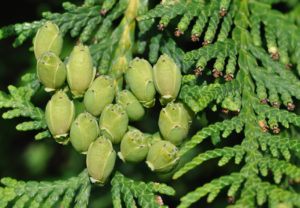Thuja occidentalis, also known as white cedar, is an evergreen coniferoustree, in the cypress family Cupressaceae, which is native to eastern Canada and much of the north, central and upper Northeastern United States, but widely cultivated as an ornamental plant.
Contents
Uses
Thuja is used for respiratory tract infections such as bronchitis, bacterial skin infections, and cold sores. It is also used for painful conditions including osteoarthritis and a nerve disorder that affects the face called trigeminal neuralgia.
Some people use thuja to loosen phlegm (as an expectorant), to boost the immune system (as an immunostimulant), and to increase urine flow (as a diuretic). It has also been used to cause abortions.
Thuja is sometimes applied directly to the skin for joint pain, ostearthritis, and muscle pain. Thuja oil is also used for skin diseases, warts, and cancer; and as an insect repellent.
In foods and beverages, thuja is used as a flavoring agent.
In manufacturing, thuja is used as a fragrance in cosmetics and soaps.
Benefits
Thuja contains essential oil (0.4 to 1%) which mainly consists (up to 65% ) of the poisonous chemical thujone. Other ingredients found in the plant are sesquiterpenes, flavonoids, mucus substances, tannin, and polysaccharides.
The tree was used traditionally for centuries by the native Americans to treat a variety of ailments and later adopted by the European settlers. A decoction made from the young twigs and leaves was used to treat cough, fever, headache, intestinal parasites, cystitis and venereal diseases. Externally, thuja was used as a poultice to treat burns, rheumatism, gout, arthritis, warts and psoriasis.
The Native Americans would burn the tree to produce thick smoke as it was their believe that the smoke could keep evil spirits at bay.
Today, thuja is mostly used against warts and polyps, but to some extent it is also used as a remedy for acute bronchitis and other respiratory disorders due to the herb’s expectorant and anti-catarrhal properties.
Thuja is a diuretic and has been used to treat cystitis and bed-wetting in children. Extracts of the herb can be applied to painful joints and muscles to increases blood circulation and thus reduce pain and stiffness.
To get rid of warts the herb was used as a topical treatment and applied either as a tincture or essential oil. Usually, a topical treatment involving a tincture should be continued for a few weeks for the best results. The essential oil is only used to burn away the warts. When the oil is used in this regard, glycerol is applied to the area surrounding the wart as a protection and then the poisonous essential oil is used on the wart itself.
Some research studies have shown that thuja has antiviral properties although it is not yet clear which substances are responsible for this effect. Despite the fact that the herb has been used for hundreds of years in folk medicine there has been little scientific research on the theraputic benefits of the plant, at least if compared with some other more known viral inhibitory herbs like echinacea (Echinacea spp). Thuja has also antibacterial and antifungal properties and can therefore be used for the treatment of infected wounds, burns and skin infections such as ringworm.
Cautions
Thuja is LIKELY SAFE when taken by mouth in food amounts, but there isn’t enough information to know if it is safe when used in usual medicinal amounts. An overdose of thuja can cause queasiness, vomiting, painful diarrhea, asthma, seizures, and death.
Thuja products can contain a chemical called thujone. Thujone can cause low blood pressure, asthma, seizures, and death.
Special Precautions & Warnings:
Pregnancy and breast-feeding: It’s LIKELY UNSAFE to take thuja by mouth if you are pregnant. Thuja might cause a miscarriage.
It is also LIKELY UNSAFE to take thuja by mouth if you are breast-feeding because of possible toxicity. Stay on the safe side and avoid use.
“Auto-immune diseases” such as multiple sclerosis (MS), lupus (systemic lupus erythematosus, SLE), rheumatoid arthritis (RA), or other conditions: Thuja might cause the immune system to become more active, and this could increase the symptoms of auto-immune diseases. If you have one of these conditions, it’s best to avoid using thuja.
Seizures: Taking thuja might cause seizures in some people. Don’t take thuja if you have a history of having seizures.
Interactions
- Medications that increase the chance of having a seizure (Seizure threshold lowering drugs) interacts with THUJA
Some medications increase the chance of having a seizure. Taking thuja might cause seizures in some people. Taking medications that increase the chance of having a seizure along with thuja might increase the risk of having a seizure. Do not take thuja with medication that increases the chance of having a seizure.
Some medications that increase the chance of having a seizure include anesthesia (propofol, others), antiarrhythmics (mexiletine), antibiotics (amphotericin, penicillin, cephalosporins, imipenem), antidepressants (bupropion, others), antihistamines (cyproheptadine, others), immunosuppressants (cyclosporine), narcotics (fentanyl, others), stimulants (methylphenidate), theophylline, and others. - Medications used to prevent seizures (Anticonvulsants) interacts with THUJA
Medications used to prevent seizures affect chemicals in the brain. Thuja may also affect chemicals in the brain. By affecting chemicals in the brain, thuja may decrease the effectiveness of medications used to prevent seizures.
Some medications used to prevent seizures include phenobarbital, primidone (Mysoline), valproic acid (Depakene), gabapentin (Neurontin), carbamazepine (Tegretol), phenytoin (Dilantin), and others.
Other names
References
Source: WebMD, http://www.webmd.com/vitamins-supplements/ingredientmono-1117-thuja.aspx?activeingredientid=1117&activeingredientname=thuja
Wikipedia, https://en.wikipedia.org/wiki/Thuja_occidentalis
Herbal-supplement, http://www.herbal-supplement-resource.com/thuja-benefits.html

